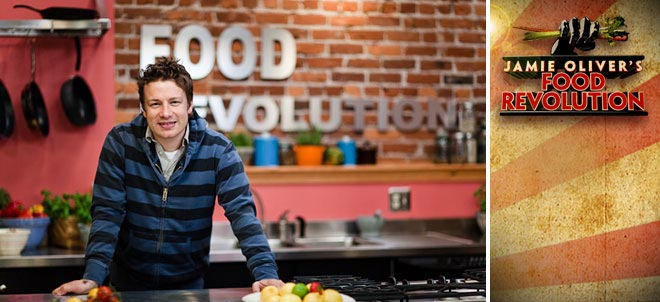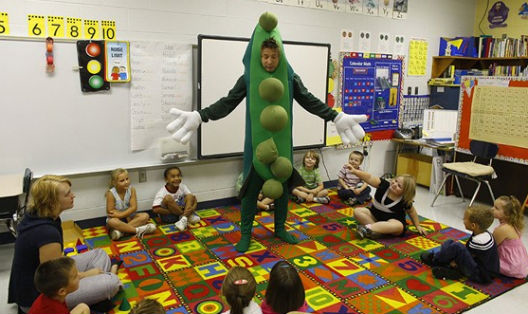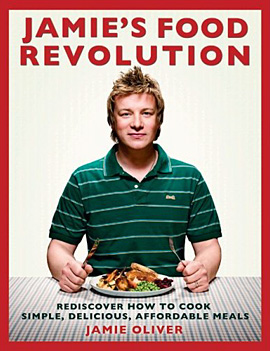Jamie Oliver’s Food Revolution: Serving Up A Side of Individual Blame
Melissa Click / University of Missouri, Columbia

Jamie Oliver’s Food Revolution, co-produced by Fresh One and Ryan Seacrest Productions, premiered on ABC on March 26, 2010 to 7 million viewers. The six-episode series aimed to bring a revolution to Huntington, West Virginia, a five-county metropolitan area (including West Virginia, Kentucky, and Ohio), which was named by the Centers for Disease Control and Prevention as the “unhealthiest in America.”1 The study, based on 2006 data, found that 45% of adults in the Huntington-Ashland metropolitan area were obese and that the area had the highest incidence of heart disease and diabetes in the United States.2 Like much of the country, Huntington could use some schooling to improve its citizens’ health, but I am not convinced ABC’s reality program fits the bill.
British chef Jamie Oliver is no stranger to US television. His programs The Naked Chef and Jamie at Home, have been staples on the Food Network. His success as a famous chef has made him a “full-fledged brand, complete with restaurants, magazines, cookbooks and housewares.”3 To date, Oliver has produced 12 television series shown in 130 countries, has published 24 million cookbooks in 56 countries, has opened six restaurants and has his own magazine, cookware, and tableware. He is estimated to be worth $56 million.4

Oliver is clearly a successful businessman, but he is also unquestionably passionate about food. Oliver began working with food at a young age at his parents’ pub, The Cricketers, but food became his life’s work when he left school at age 16 to complete a degree at Westminster Catering College (he is rumored to be hyperactive and dyslexic and had difficulty with academics as a result).5 To use food to help others find their way, Oliver created the Fifteen Foundation in 2002, which sponsors 15 young adults from disadvantaged backgrounds in apprenticeships to the foodservice industry in one of the foundation’s four restaurants.
Oliver is well known in the UK for political series and specials that take British eating habits to task, including Jamie’s School Dinners, an award-winning four-part series that aired in 2005 on Channel 4 in which Oliver took over the production of meals at Kidbrooke School in Greenwich (Jamie Oliver’s Food Revolution is based upon this documentary). In each of his programs, Oliver stresses the idea that anyone can learn to cook healthy meals with simple and fresh ingredients. After learning about the CDC’s report on Huntington, Oliver decided to bring his food activism and television cameras to the United States. Critical of his motives, The Washington Post credited Oliver with having “… the kind of warm-hearted caring that requires the constant presence of a TV crew.”6
In the premiere episode, viewers learn that Oliver has been given one week at Huntington’s Central City Elementary School to prove that he can make healthier meals that kids will like and that will fit within the school’s budget. Immediately Oliver gets off on the wrong foot with the cafeteria cooks, most notably Alice Gue, by dismissing the items they have prepared for the students (pizza for breakfast and chicken nuggets for lunch). He does not hide that the food “pisses me off.” Though he claims to be “always on the side of the cooks,” he alienates them by constantly referring to them as “lunch ladies,” “honey,” “babe,” “girls,” and “darling” (In fact, he calls nearly every woman he encounters by these terms, regardless of the woman’s age or status). He suggests that the food served by the cooks is “killing” the school’s children and connects Huntington’s habits with the rest of the country by dismissively saying, “Welcome to America.”

In addition to working at the elementary school, Oliver sets up a community kitchen downtown called “Jamie’s Kitchen.” In it he hopes to teach families and individuals to cook healthy meals from scratch. One of the first families he teaches are the Edwards, an overweight family of six who are suggested to Oliver by their pastor. Oliver targets Stacie Edwards, the wife and mother of the family. To drive home his disgust for the family’s typical fare, he piles on their kitchen table all of the meals Edwards would fix for her family in one week and tells her that she’s serving her family “crap.” The stunt brings her to tears when Oliver stresses that serving this food “will kill your children early.” To begin to reform the family’s eating habits, he has them bury their deep fryer in the back yard and leaves them with bags full of groceries he purchased and a week’s worth of recipes.
It would be hard for viewers to disagree with Oliver’s characterization of the food he encounters in Huntington as “crap,” but his approach comes off at times as condescending and focuses on blaming individual people (especially mothers and female food workers) for their food habits instead of larger systemic forces (such as economics, culture, advertising, agriculture, or US government policy). AlterNet described Oliver’s style this way: “Take marginal people, make them feel shitty about themselves, offer redemption and serve it up to millions of viewers”7 Oliver generally seems to lack a cultural sensitivity to the people of Huntington who live in a city where the poverty rate (19%) is “much higher than the national average,”8 and Oliver surprisingly never acknowledges that the food we eat is based in part on culture and identity.
As a result, Oliver is met with resistance in Huntington, most notably from local radio personality Rod Willis, who tells Oliver in the fourth episode “I want to like you, but I don’t trust how the show’s going to turn out.” West Virginians have typically been maligned for being backwards hillbillies who eat ‘possum and make moonshine, so it is no wonder that Oliver faces suspicion in a variety of places: from the hospital administrators whom he asks for money, and from the elementary school staff who corner him after a negative interview is published in the local newspaper. The locals’ suspicion is palpable—they repeatedly voice their fears that Oliver is trashing Huntington for TV ratings.

It wouldn’t be reality TV if Oliver did not win over the majority of his detractors, and by the series finale Oliver rolls out his food plan to all of the schools in the area with the support of Alice Gue, Rod Willis and hospital administrator Doug Shiels. Oliver won the hearts and trust of many in Huntington by dressing as a pea pod, organizing a flash mob, and holding a cook-a-thon—all good reality television stunts. But he does so almost always on his own terms—as his program title indicates, this is Oliver’s revolution, not Huntington’s.
What is missing from the show is an analysis of the structures that hold this undeniably unsatisfactory food system in place. Take schools, for example. To receive federal reimbursement for school lunches (which turns out after labor, transportation, and administration costs to be only about $1 per meal),9 schools must meet a confusing number of USDA-mandated regulations. And schools are only reimbursed for the number of meals served, so to keep kids happy, they end up treating them more like customers than students, serving them what they want instead of what they need. Given the bind many schools are in financially, processed food from big food manufacturers that needs only to be warmed makes good financial sense. Oliver never acknowledges this nor does he reveal that the food budget at Central City Elementary “more than doubled” while he was head cook—ABC paid the excess.10 As wonderful as Oliver’s goals for school children’s food are, they do not seem to be sustainable under the current National School Lunch Program.
Oliver also does not acknowledge the range of likeminded individuals and organizations across the United States who are working to change the national food system. Left out of Oliver’s plan to inspire Americans to eat differently are President Obama’s call to increase funding for the Child Nutrition Act, Michelle Obama’s Let’s Move initiative, the Agriculture Department’s plans to overhaul school nutritional guidelines, and the recent call by a US military group to improve school meals. Oliver’s “revolution” might have been stronger had he chosen to link up with national organizations like the Center for Science in the Public Interest or the School Nutrition Association. And if those organizations seem too mainstream, Oliver could have found allies in Two Angry Moms or the author of Fed Up With Lunch. Without tapping these other resources, Oliver’s program feels a bit more like an extended promo for his new book Jamie’s Food Revolution than an earnest attempt to make real and lasting change in the United States.
Image Credits:
1. Jamie up close and personal
4. Book cover
Please feel free to comment.
- Witchel, A. (2009, October 11). Putting America’s diet on a diet. The New York Times, Retrieved April 29, 2010 from http://nytimes.com, para. 3 [↩]
- Witchel, A. (2009, October 11). Putting America’s diet on a diet. The New York Times, Retrieved April 29, 2010 from http://nytimes.com, para. 3 [↩]
- Carter, G. (2010, March 26). A recipe for a ‘Revolution.’ USA Today. Retrieved April 20, 2010 from EbscoHost database, para. 7 [↩]
- Witchel, A. (2009, October 11). Putting America’s diet on a diet. The New York Times, Retrieved April 29, 2010 from http://nytimes.com, para 16 [↩]
- Witchel, A. (2009, October 11). Putting America’s diet on a diet. The New York Times, Retrieved April 29, 2010 from http://nytimes.com, para. 7 [↩]
- Stuever, H. (2010, March 20). ‘Jamie Oliver’s Food Revolution’ regurgitates the worst of reality TV pap. The Washington Post, Retrieved May 3, 2010 from http://www.washingtonpost.com, para. 1 [↩]
- Gupta, A. (2010, April 8). How TV superchef Jamie Oliver’s ‘Food Revolution’ flunked out. AlterNet, Retrieved April 8, 2010 from http://www.alternet.org, para. 18 [↩]
- Witchel, A. (2009, October 11). Putting America’s diet on a diet. The New York Times, Retrieved April 29, 2010 from http://nytimes.com, para. 3. [↩]
- McGray, D. (2010, April 26). The war over America’s lunch. Time, Retrieved April 29, 2010 from http://www.time.com, para. 6. [↩]
- Gupta, A. (2010, April 8). How TV superchef Jamie Oliver’s ‘Food Revolution’ flunked out. AlterNet, Retrieved April 8, 2010 from http://www.alternet.org, para. 3. [↩]
I absolutely agree with this analysis. What I found particularly disturbing about this show, as a gender scholar, is the inordinate amount of responsibility he levels at at mothers and female caregivers. Yet another example of the ways in which systemic issues are framed as personal and individual–thus undermining the call for changes at the political/economic level.
I’d say then we need to change the National School Lunch Program. We can pick up where Oliver left off, I like to think, not just say he didn’t do enough or the right way. Oliver can’t do everything that needs to be done, but he’s trying to do something. If he blames moms and female caregivers, it’s probably simply because they are the main ones feeding junk to kids. No, it’s not the school cooks’ fault, the higher-ups need to put in changes, but I think we need to address any and all levels to get change.
I guess, if you are dealing in broad sweeping terms, that the majority of people responsible for food are women, while this does enforce typical gender roles, surely it is more stating fact than some pre-determined desire to enslave women.
Despite the fact your “analysis” spends an inordinate amount of time on synopsis, there are multiple points in the show that deal with larger economic and structural forces––not just moms. Oliver’s battles with administrators who are concerned with economics instead of nutrition and dealing with misguided school lunch nutritional standards (where french fries and ketchup are considered vegetables) take up far more of the series than blaming mothers. (In fact, the only time he directly confronts a mother––not parents or other caregivers––is in the first episode where a woman literally fried every meal she cooked for her family.) If there were said to be a villain in the show, it’s the school administrator who routinely complains about food waste, demonstrating an inflexible compliance to standards that eschews common sense, not allowing forks or knives in the cafeteria; Alice and company may comically grouse, but they come through. Further, there are several points at which Oliver condemns loopholes the food industry use to get into schools unregulated: the posters advertising flavored milk, the fact that these milks have more sugar than pop but are allowed because it’s “healthy”, the fact they cannot be removed because children may not choose to purchase milk entirely. Oliver also debunks prepackaged “lunchables” that market themselves as healthy. There’s even an visit to the frozen food supplier for the schools that shows they also carry fresh food, but price it unrealistically. This company is even shown screwing up an order (frozen chicken is delivered when they ordered fresh) and the cooks are forced to use it because it would be illegal––how is that not showing the roots of the problem? Even though it’s not nearly as hard-hitting as The Omnivore’s Dilemma or Food Inc., cut through the flashy idiocy of the reality show format and see what it actually reveals about the system!
What’s disappointing about shows like these is that we hold them accountable for changing the world in some real, valid way. Reality television differs from news and charity work in that it is required to neither be transparent nor well-intentioned. Clearly, this show barely achieves its main goal, namely, to entertain and drive consumerism. It would be fascinating to watch this program through the lens of public television, with social impact as a priority. Would the focus be less on humiliating the residents of Huntington County and actually helping them make a difference? What if we put it through the news filter? Would the focus be on the flaws of the system?
Even with an approach of entertaining the masses, the show is not catching on. “Fat” is not something people want to be called these days. Through any filter.
Thanks for the links to some great blogs!
Thanks everyone for your comments! Anna: I totally agree with you that something needs to be done about school lunches. And I agree with you that Oliver is trying to do something–it just feels disingenuous to me to do it through reality TV. And Violet: I agree with you that there are moments in the show where the connection to larger structural and economic forces show through–but I believe that the show does not interrogate those moments as much as it should. A show where Oliver pits himself against the local school system makes for better TV than a show where Oliver pits himself against Congress, the USDA, or the National School Lunch Program. Oliver has a decent amount of celebrity power to actually do something about this crisis, I just don’t think he picked the right place to begin. I also don’t think the inordinate amount of attention spent on the personalities of the local school system (the majority of whom have little power to make anything change) moves the food movement forward.
One of the things I think the US food movement needs now is dialogue about how and where change should take place, which is why I’m so grateful for your comments. We have a incredible amount of work to do!
“Fat” is not something people want to be called these days. Through any filter.
JMS – wow. You really need to Google the Fat Acceptance Movement and catch up with reality. There are quite a number of us who proudly declare that we are fat, regardless of the “filter” whatever that means.
Violet – If there were said to be a villain in the show, it’s the school administrator who routinely complains about food waste, demonstrating an inflexible compliance to standards that eschews common sense,
The school administrator has a job to do and is required to comply with the federal standards in order to get federal money. The school system was extremely worried they were not going to be able to pay for the waste Oliver was inducing into the school. Making the administrator the bad guy would be grossly unfair – particularly since you suggest s/he should be the bad guy for following the rules of hir job. The people who work in the US school system are doing the best they can under bad policies that come down from the government. If Oliver actually cared about changing the system, he’d haul his publicity-loving butt to D.C. and start chasing down members of Congress and bringing the issue of how little money we’re spending to subsidize school lunches to their attention. But as others have said, it makes for better tv for him to shame some fat women for being fat (and poor, since obesity rates are very closely linked to poverty rates) than for him to actually try to promote real, systemic change.
DRST: Yes, she is doing her job. But at what point do we stop being cogs in a machine and stop these larger forces? I think it’s this type of complacency that has let food industry lobbyists get away with all they have. Let us not forget that he did the exact same thing in England (which I have not seen but am sure was just as tawdry/cloying at moments) which then created government legislation to change school lunch programs nationwide.
Pingback: Selectism | Around the Web | Selectism.com
Pingback: Selectism | Around the Web | selectism
Melissa wrote: “What is missing from the show is an analysis of the structures that hold this undeniably unsatisfactory food system in place.”
Agreed.
To find out about just such an analysis please visit: http://www.facebook.com/lunchlinefilm
This is really interesting, Melissa, and a good starting point for a lot of great discussion. I’ve only seen a couple episodes of the series, but had similar feelings of discomfort after viewing. Not that Oliver’s goals aren’t noble (they are, I think, even when viewed through the veil of celebrity), but there are real systemic issues that simply aren’t being addressed. When I teach public speaking, I always have students who want to give persuasive speeches arguing that people should just eat healthier foods in order to combat obesity. Lovely in theory, but there are very real economic and cultural issues that make such simplistic changes unreasonable and untenable–as you note here.
I do think, though, that even if Oliver’s “solutions” (such as doubling the budget, etc.) may not work in the long run, they do a good job of alerting the American public to the problems of school lunches. I know of many folks (of all ages and stages of life) who were frankly appalled at what they saw on the show, and felt compelled to do something about it–join a group, sign a petition, lobby for change at their own children’s schools. To my mind, this is the benefit of Food Revolution–shining light on a problem many of us are either unaware of or choose to ignore.
I really appreciate the summary and analysis you’ve done here–and the points of contention you’ve proposed. There are certainly many flaws with the series, and even more points of discomfort. It’s absolutely worth taking a closer look and interrogating the series, its production, its motives and its results. Thanks for a great piece!
Thanks for the tip, I will try it out :)
Cheers
Bo
http://italienskrestaurantkøbenhavn.dk/
Wow that was unusual. I just wrote an incredibly long comment but
after I clicked submit my comment didn’t show up. Grrrr… well I’m not writing all that over again.
Anyhow, just wanted to say great blog!
We see here an administrator who promote the notion that processed food from big food manufacturers that needs only to be warmed makes good financial sense. A “school cook” who offers pre-fab pizza for breakfast! An entire region that is grotequely obese and brags about it. An “academic” who denounces Oliver for not taking on Congress and the USDA.
And finally, a Captcha verifier that asks us to identify chocolate chip cookies.
I must agree, Mr. Oliver is wasting his time with these people
In my opinion, KFC is the biggest food revolution in the world. Present KFC is the 4th biggest food chains in the world. KFC is in more than 20,500 locations all around the world, and more than one lakh people are working in the KFC restaurants. Chicken stripes and chicken wings are very famous in the KFC restaurants. MY kfc experience is the official customer satisfaction survey conducted by kfc restaurant management. This survey is the proper way to collect the customer’s feedback. KFC restaurant management decided to improve its services by using the customer’s feedback; that’s why they are conducting this survey, and you have a chance to win chicken items for free by taking this survey.
Thanks for the amazing post.
Thanks for sharing this information. I really like your post very much. You have really shared an informative and interesting post with people
Thanks for the great information. I loved reading your post. I love to enjoy the Shoneys Breakfast with my friends.